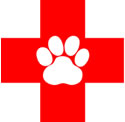Hydrocephalus refers to water in the brain or overdistension of the ventricular system from cerebrospinal fluid (CSF) accumulation. Hydrocephalus is broadly defined by pathophysiology as an active distension of the ventricular system of the brain related to inadequate passage of CSF from its point of production within the ventricular system to its point of absorption into the systemic circulation. An animal diagnosed as being hydrocephalic has clinical signs of neurologic dysfunction related to the dilated ventricles. Causes of obstructive hydrocephalus are classified as congenital or acquired. Acquired hydrocephalus usually occurs when a disease process, such as a brain tumor, hemorrhage or inflammation, occludes the flow of CSF. Congenital hydrocephalus is a common distinct entity in some toy and brachycephalic breeds (e.g. Boston terrier, cavalier King Charles spaniel, Chihuahua). A commonly identified cause in predisposed breeds is narrowing or blockage of the CSF flow in the ventricular system. Neonatal infections, such as those with viral causes, can result in stenosis without leaving any indications of the cause once the initial inflammation has resolved. However, the strong breed predilection suggests a hereditary basis in many of these dogs.
Clinical Signs
Onset and rate of progression of clinical signs is variable in dogs and cats with diagnosed congenital hydrocephalus. Clinical signs include behavioral changes, slowness in learning (e.g. housebreaking) loss of coordination, visual deficits and seizures. Physical features may include an enlarged and dome-shaped skull. Presence of a molera (opening in the top of skull) is common in many toy breeds; however, does not necessarily indicate presence of hydrocephalus. Lateral deviation of the eyes is common in congenital hydrocephalus. Even in congenital cases, the disease may follow a waxing and waning course. Sometimes dramatic hydrocephalus may be present but the owners report few clinical signs other than learning deficits.
Diagnosis
A minimum database to include complete blood count, biochemical analysis, and urinalysis is useful to exclude other underlying systemic diseases that also can mimic signs of hydrocephalus. These diagnostic testing procedures also ensures the animal is healthy for anesthesia. Magnetic resonance imaging (MRI) is the preferred imaging technique for diagnosis of hydrocephalus. MRI provides detailed imaging with respect to obtaining a definitive diagnosis, identifying other congenital abnormalities and determining secondary pathologic effects (e.g., edema, mass effect). If a skull defect is present, an ultrasound can be used to visualize and determine the presence of hydrocephalus.
Treatment
The choice of treatment is guided by the patient’s neurologic and physical status and age, and the underlying cause. Medical management of hydrocephalus is largely symptomatic by reducing intracranial pressure and CSF production. Antiepileptic drugs are administered to control seizures. Surgical treatment involves shunting of CSF away from the obstructed regions of the ventricular system and is reserved for animals with worsening of neurologic signs that do not respond or become refractory to medical therapy. Placement of a drainage device (shunt) diverts CSF from the ventricles through a low-pressure valve and reservoir to another site such as the peritoneal space, atrium of the heart or subcutaneous tissue.
Prognosis
Prognosis for severe congenital hydrocephalus is usually guarded as clinical signs are often severe at presentation. Approximately 70 percent of dogs and cats with congenital hydrocephalus and shunt placement will show improvement of clinical signs. However, complications after shunt placement are not uncommon and most likely to develop within the first three months after surgery. Common complications include shunt migration from the skull, mechanical failure, infection and occlusion of the shunt.



